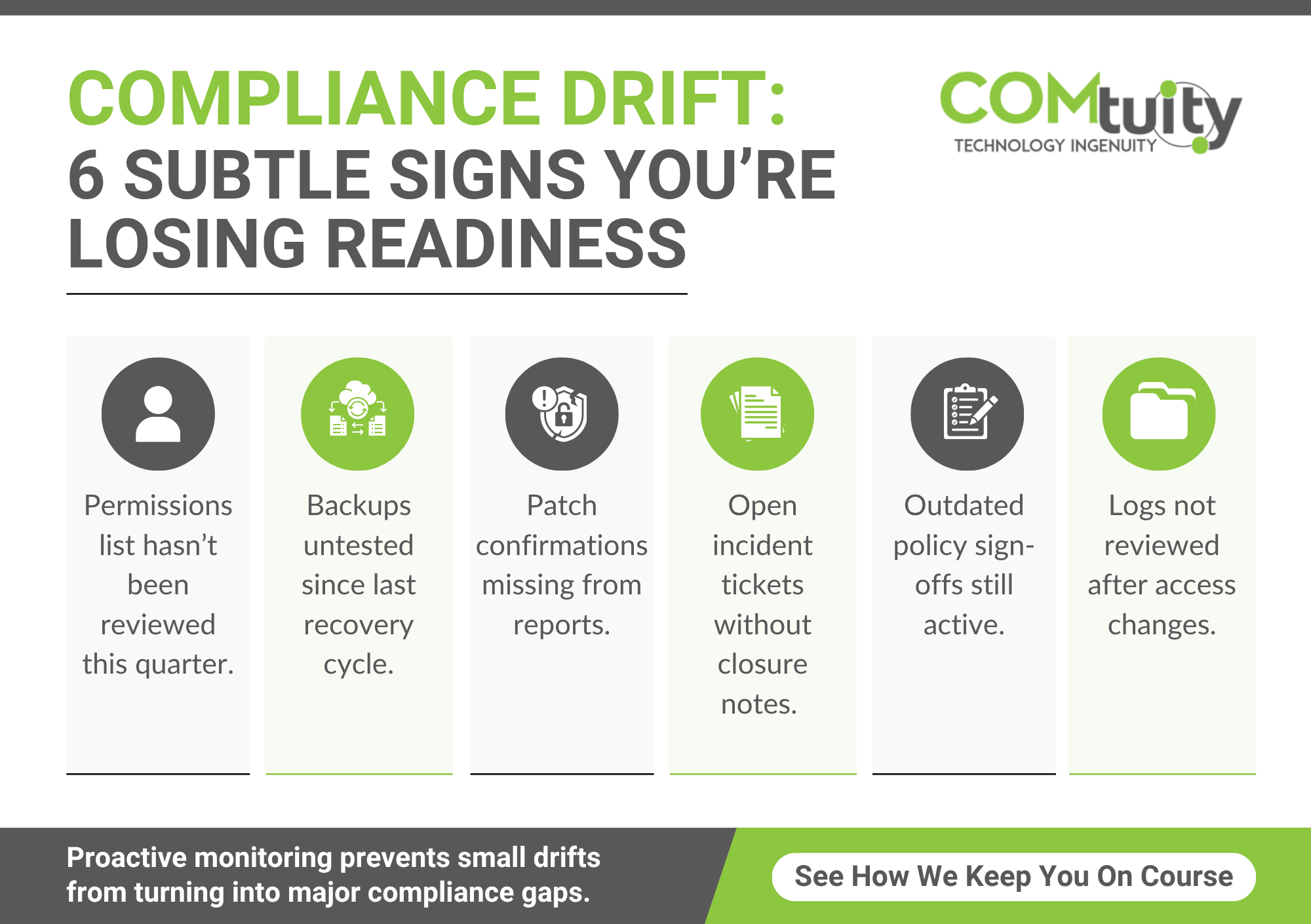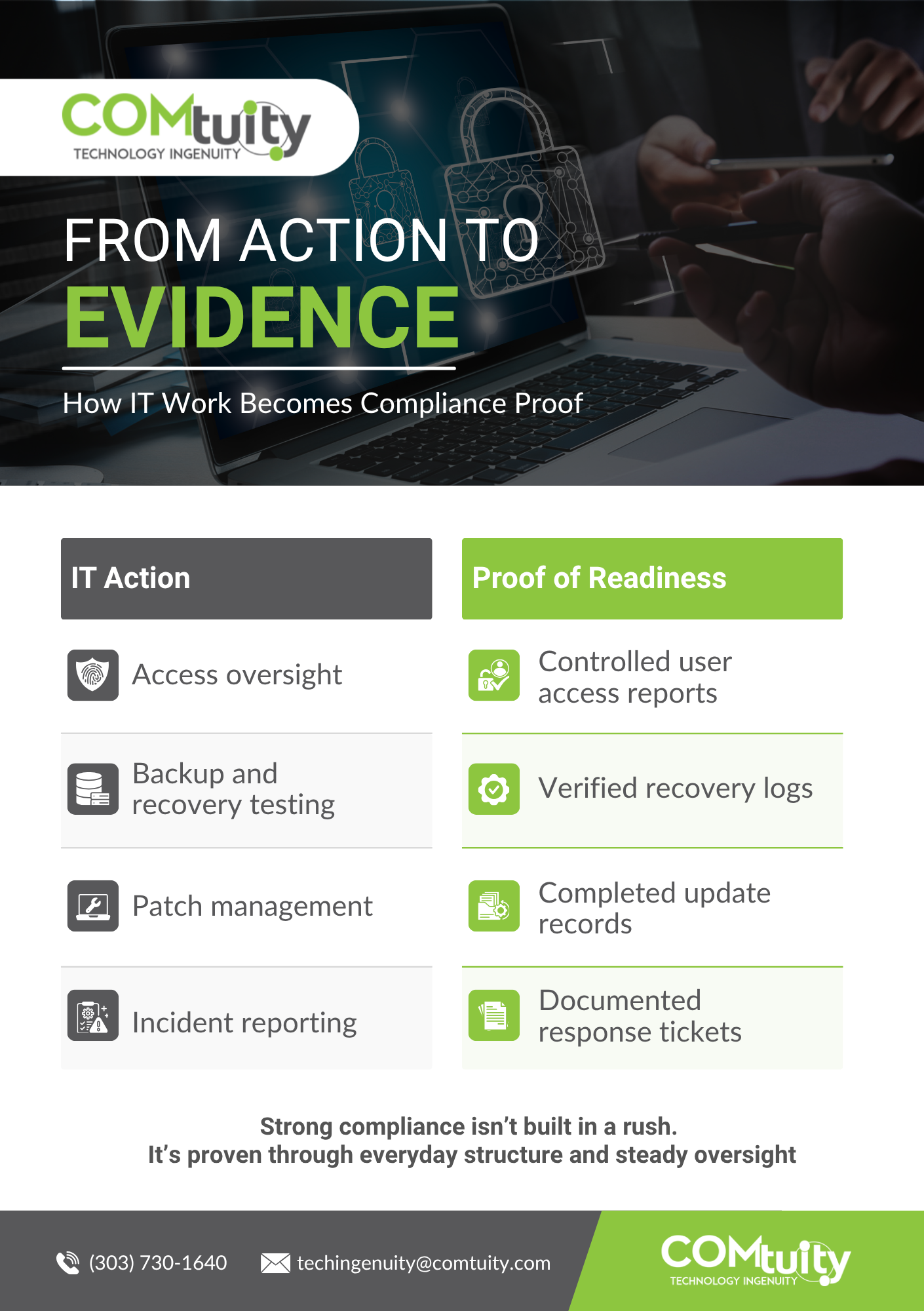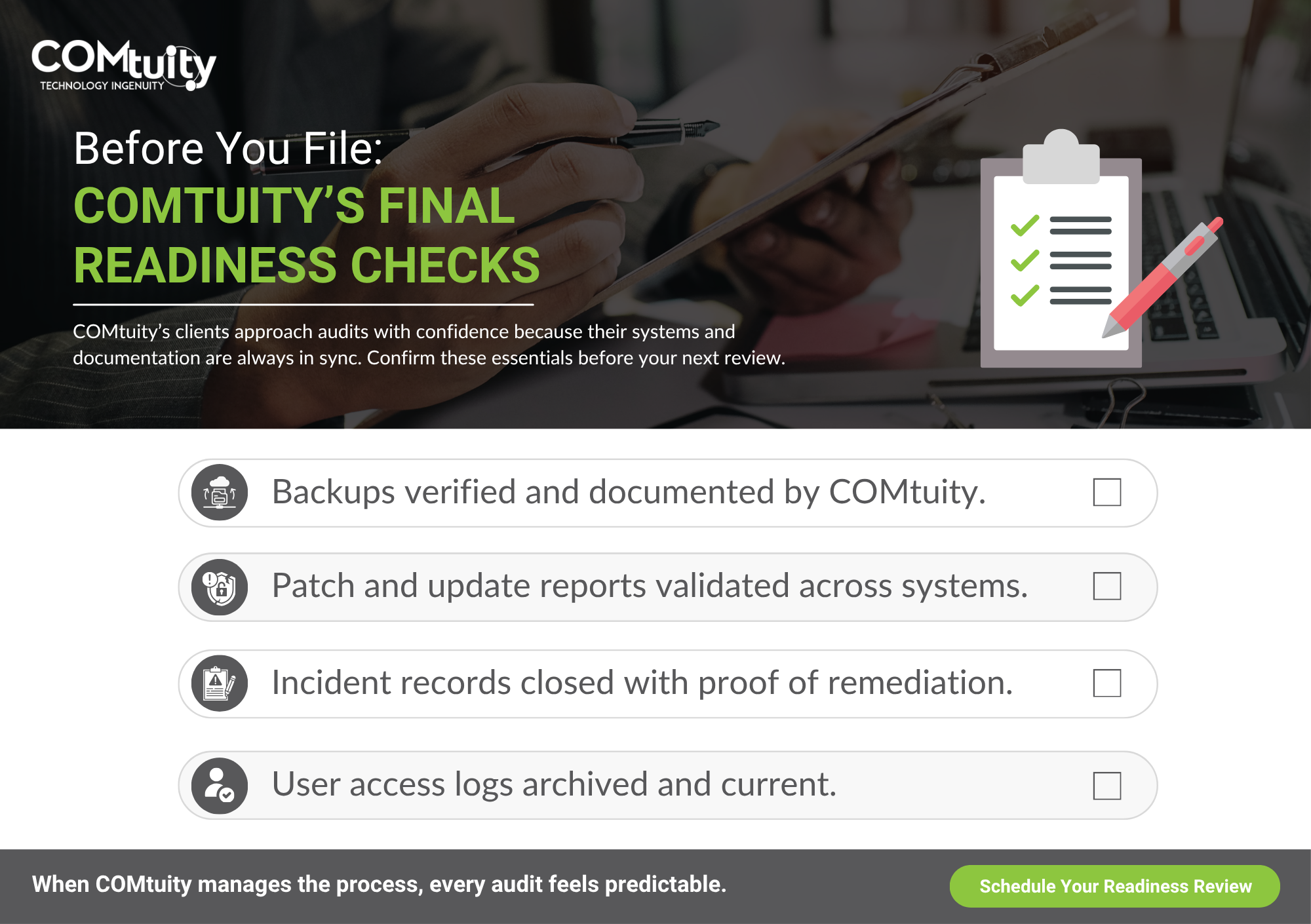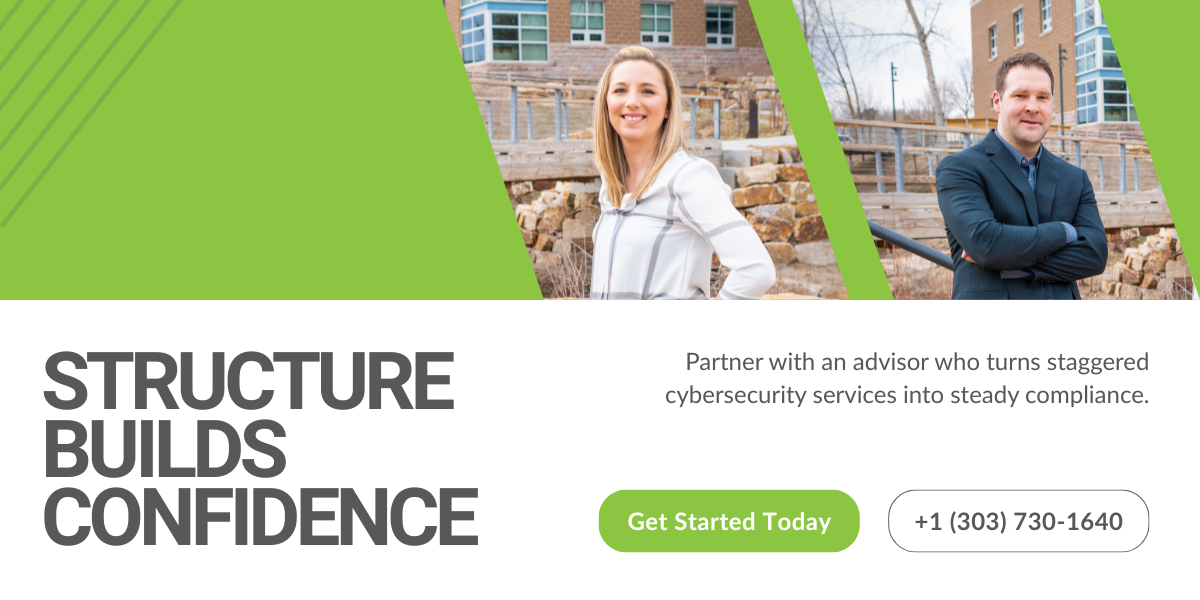Compliance should never feel like a race against time. Yet for many businesses, that’s exactly how it plays out. Often, policies are drafted, systems are audited, and evidence is gathered only when an audit looms. What’s missing isn’t effort, it’s structure.
Recent studies show that 78% of SMBs fear a single cyber attack could put them out of business. That means they lack the strategy and the operational capability to face advanced threats. So, if your cybersecurity is lacking, you’re not alone.
At COMtuity, we can help. We guide the shift from reactive preparation to steady readiness. Through ongoing advisory of cybersecurity, vendor management, and more, your team stays organized and audit-ready all year long.
True compliance doesn’t come through last-minute fixes; it comes through consistent attention. Here’s how structured cybersecurity services guide your organization toward compliance with less chaos and more confidence.

Why Compliance Starts with Optimized IT Systems
Compliance begins where your technology environment stabilizes. Outdated systems, mismatched hardware, or untracked configurations create risk that can ripple through every department. When your IT systems are optimized and documented, your compliance work gains a solid foundation.
That’s why we start by aligning the basics: your network, devices, and cloud environments. When those layers work together, it’s easier to control access, log activity, and produce consistent data trails.
Optimized systems don’t just improve performance. They simplify your entire compliance process and improve accountability.
The Hidden Gaps Cybersecurity Services Help Close
Most compliance risks live in the blind spots, areas your team assumes are covered but aren’t. Without visibility, even small inconsistencies can escalate into compliance issues that are costly to trace and correct later.
Common examples include:
- Endpoint protection that isn’t updating as expected
- File transfers or backups running without encryption
- Third-party platforms with unrestricted access
- Logs that don’t capture full user activity
- Firewall rules that remain open after temporary changes
- Cloud configurations that don’t follow company policy
Each small gap adds complexity when you need to prove compliance. However, cybersecurity services help uncover those hidden weak points before they become findings in an audit.
Our goal is to make your environment predictable. By coordinating across all providers and platforms, we help ensure nothing slips through the cracks. When every system, vendor, and policy follows the same playbook, readiness becomes routine, not reactionary.
Building Proof Through Continuous Visibility and Monitoring
Compliance isn’t only about having controls in place. It’s about proving those controls are active, consistent, and measurable. Continuous visibility makes that possible.
According to the Cisco 2025 Cybersecurity Readiness Index, 70% of U.S. organizations remain in the bottom two readiness categories. Often, they lack real-time visibility across identity, network, and cloud activities.
It Can Happen to You
A multi-location retailer notices some odd access activity across a few stores. Without structured monitoring, no one’s quite sure who should follow up. The logs are incomplete, details get lost, and when it’s time to show proof, the team has to piece together what happened. Nothing catastrophic, but confidence takes a hit.
How It Looks When It’s Managed Well
Now, picture the same situation with structured monitoring in place. The alert comes through clearly, the activity is reviewed, and every action is documented. The team can see what happened, when it happened, and what was done to fix it.
Instead of scrambling for answers later, they already have a full record ready to share. That kind of visibility builds trust, keeps operations steady, and turns compliance into something continuous instead of reactive.
This kind of visibility gap is easy to overlook, especially when systems seem to be running smoothly. But even well-managed environments can drift without structure.
Controlling Access and Protecting Sensitive Data
Access control sits at the center of every compliance framework. Who has access to what? How is that access granted, reviewed, and removed? Without clear answers, compliance turns into guesswork.
We help simplify that complexity. Through structured oversight and coordinated vendor solutions, we make sure users only have the access they truly need. That includes aligning permissions across cloud tools, servers, and on-site systems so policies stay consistent everywhere you operate.
Access control is about accountability. When permissions are reviewed regularly and changes are tracked, your data stays protected and your audit documentation stays accurate.
This balance extends beyond digital systems. For multi-location businesses, physical security plays just as big a role. Door access, surveillance, and alarm integrations all need to align with your data protection policies. We help bring those layers together so your compliance reflects real-world control, not just written policies.
When every access point, both digital and physical, follows the same standard, your risk drops and your proof of control becomes clear.
Turning Incident Response into Measurable Readiness
Security events happen in every organization. What separates those who recover quickly from those who struggle is structure. A defined response plan turns unexpected moments into opportunities to strengthen compliance. It helps teams act with clarity instead of urgency and creates a consistent process that builds confidence over time.
We help businesses bring structure to their response workflows by coordinating clear communication paths, response timelines, and documentation practices across all vendors and locations. Each incident is reviewed, logged, and linked to the relevant compliance controls—so every response becomes measurable evidence of readiness.
We also coordinate regular response testing with vendor partners to ensure alerts trigger correctly, responsibilities are clear, and systems perform as expected. When incident response is consistent and verifiable, compliance becomes a natural part of operations rather than an afterthought.
Ensuring Backup and Recovery Meet Compliance Standards
Backup and recovery are often treated as routine IT functions, but they’re also central to compliance. Regulators and auditors expect proof that your data is protected, recoverable, and tested regularly. That’s why structured oversight matters. By coordinating vendor processes, verifying documentation, and maintaining consistent testing records, you can avoid last-minute surprises when evidence is requested.
Here’s what that structure can look like in practice:
- A regional healthcare provider identifies that one clinic’s backup data is stored outside its approved region. With regular oversight, that issue is corrected before an audit, and recovery logs confirm compliance.
- A manufacturing company conducts quarterly disaster recovery tests that simulate server failure. Each test produces a timestamped report showing how long restoration took and which systems came online first, creating a clear audit trail.
- A financial services firm rotates backup encryption keys quarterly and logs every access to its backup repositories. Each review reinforces security and regulatory alignment.
When your backup processes are standardized and verified, you don’t just meet compliance expectations; you strengthen organizational confidence. Everyone, from IT to leadership, can trust that critical data is recoverable, protected, and managed under consistent, documented procedures.
Simplifying Evidence Collection Before the Audit Rush
The final weeks before an audit shouldn’t feel like a scavenger hunt. Yet for many organizations, evidence collection becomes a stressful scramble through outdated folders and vendor portals.
At COMtuity, we take a steadier approach. Through structured coordination across your technology ecosystem, we help centralize key documentation (policies, network logs, vendor certifications, and incident reports) into one accessible, organized system.
This continuous documentation cycle removes the chaos from compliance. Instead of gathering evidence reactively, your organization maintains a clear, ongoing trail of activity. Auditors appreciate the transparency. Your team appreciates the time it saves.
When documentation is part of everyday operations, audit readiness becomes second nature, and your credibility with customers, partners, and stakeholders grows stronger as a result.
All of these elements come together under one steady framework, and that’s where an advisor’s role becomes essential
FAQ: Cybersecurity Compliance
How does cybersecurity support compliance with regulations?
Cybersecurity supports compliance by implementing controls—like encryption, access management, and audit logging—that directly meet regulatory requirements (e.g., GDPR, HIPAA, PCI DSS). These measures protect sensitive data, reduce breach risks, and provide documented evidence during audits, helping organizations avoid fines and legal penalties.
What is an example of cybersecurity compliance?
An example of cybersecurity compliance is a healthcare provider encrypting patient records and conducting regular risk assessments to meet HIPAA Security Rule standards. This includes access controls, employee training, and incident response plans—all verified through annual audits.
What is the purpose of security compliance?
The purpose of security compliance is to ensure organizations follow legal, industry, and contractual standards for protecting data and systems. It minimizes cyber risks, prevents costly breaches, maintains customer trust, and avoids regulatory penalties—ultimately aligning security with business governance.
What are the best practices to ensure compliance with cybersecurity standards?
Top best practices include:
- Conducting regular risk assessments and gap analyses
- Implementing least privilege access and multi-factor authentication (MFA)
- Maintaining detailed audit logs and monitoring systems
- Providing ongoing employee cybersecurity training
- Using automated compliance tools (e.g., GRC platforms)
- Performing third-party vendor assessments
- Updating policies to match evolving standards like NIST, ISO 27001, or CIS Controls
How an Advisor Keeps Compliance Steady and Predictable
When compliance depends on multiple vendors and systems, readiness can easily start to drift. COMtuity brings structure to that complexity by coordinating every layer so your team always knows exactly where things stand.
Our advisor-led model keeps readiness predictable and stress-free. We don’t replace your internal IT team; we strengthen it. Through consistent oversight, we turn compliance from a seasonal scramble into a steady rhythm of accountability.
Your systems stay aligned. Your evidence stays organized. And your business stays audit-ready, not because you rushed, but because structure is built into the way you operate.
That’s the difference an advisor brings: clarity, calm, and confidence that lasts.
Ready to make compliance steady, predictable, and stress-free? Contact us today to partner with an advisor who turns complex compliance into continuous readiness.




